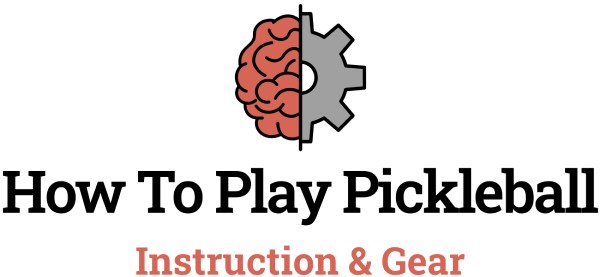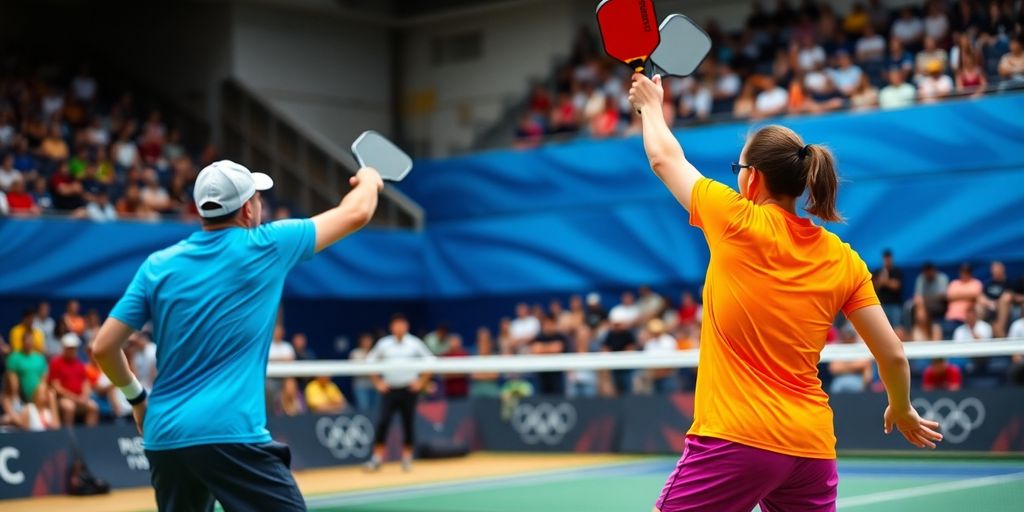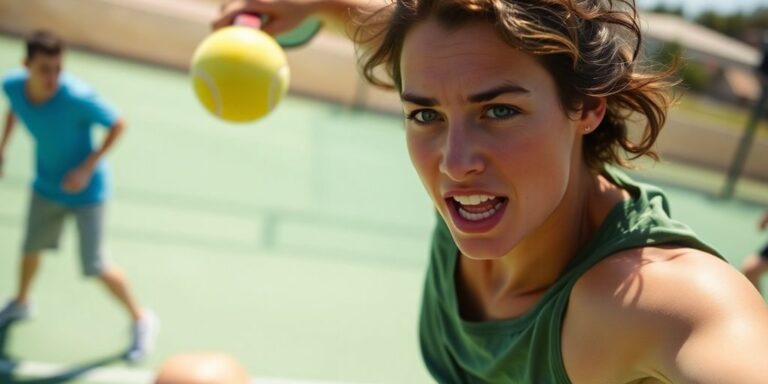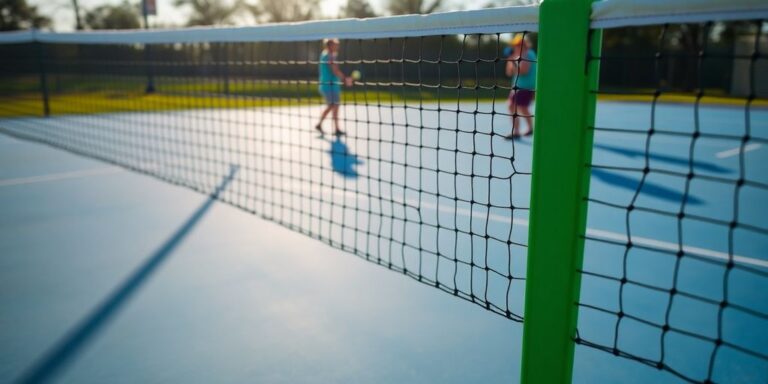Pickleball is a sport that has been gaining popularity rapidly, combining elements from tennis, badminton, and table tennis into one exciting game. With its rise in players and fans, many are starting to ask: is pickleball part of the Olympics? As we look into its current status and future in the Olympic Games, we can see both challenges and opportunities ahead.
Key Takeaways
- Pickleball is not currently an Olympic sport, but its popularity is growing.
- The sport needs to meet specific criteria set by the International Olympic Committee for inclusion.
- Efforts are being made to establish national federations and increase global participation in pickleball.
- The 2028 Los Angeles Olympics could be a significant opportunity for pickleball’s recognition.
- Community initiatives and major tournaments are helping to promote pickleball on a global scale.
Pickleball’s Journey to Olympic Recognition
Current Status of Pickleball in the Olympics
So, is pickleball an Olympic sport right now? Nope, not yet. Even though it’s blowing up in popularity, especially here in the US, it hasn’t quite ticked all the boxes the International Olympic Committee (IOC) needs to see. Getting into the Olympics is a tough process. It needs widespread play across the globe and solid, official groups running things. The International Pickleball Federation (IPF) and the World Pickleball Federation (WPF) are working hard to make it happen.
Historical Context of Pickleball’s Development
Pickleball started back in 1965, believe it or not, on Bainbridge Island, Washington. Joel Pritchard, Bill Bell, and Barney McCallum were just trying to keep their kids entertained. They threw together some equipment and rules, mixing badminton, tennis, and table tennis. It was a fun, family thing at first. Over the years, it slowly grew, but the last few years have been insane. Now, it’s not just a backyard game; it’s a real sport with leagues, tournaments, and serious players. It’s wild to see how far it’s come from those first cobbled-together games. The sport is set to expand significantly, attracting more players and transforming into a dynamic experience.
Key Milestones in the Push for Olympic Inclusion
Getting pickleball into the Olympics is a marathon, not a sprint. Here are some key things that need to happen:
- More countries playing: We need pickleball to be big in more places than just the US and Canada.
- Stronger organizations: The groups running pickleball need to be official and recognized worldwide.
- Meeting IOC rules: This means following all the guidelines the Olympics sets out.
The sport’s governing bodies are working to increase its global presence. Countries around the world are forming national federations, and international tournaments are gaining traction. As the sport continues to grow and establish a more formal global structure, its chances of being considered for the Olympics will improve.
And of course, showing that pickleball is a sport that people all over the world love to play and watch. Pickleball has been recognized as the fastest-growing sport in the United States for four consecutive years, from 2021 to 2024, according to the Sports and Fitness Industry Association.
The Popularity of Pickleball

Pickleball’s popularity has exploded, and it’s not hard to see why. It’s easy to pick up, social, and a great workout. You see more and more pickleball courts popping up everywhere. But how popular is it, really?
Growth Trends in Participation
Pickleball has seen crazy growth in recent years. It’s one of the fastest-growing sports in the US, and that momentum seems to be continuing. More people are trying it, more people are sticking with it, and that’s showing up in the numbers. It’s not just a fad; it’s becoming a real part of the sports landscape. According to USA Pickleball, membership has increased dramatically year after year. This isn’t just casual players either; these are people committed enough to join the official organization. The sport’s accessibility is a big factor. It’s easier on the body than tennis, and the smaller court size makes it less intimidating for beginners. Plus, the social aspect is huge. People love the community feel of pickleball, and that keeps them coming back.
Demographics of Pickleball Players
One of the cool things about pickleball is that it appeals to a wide range of people. You’ll see everyone from young kids to retirees out on the courts. It’s not just one age group or demographic that’s driving the growth; it’s a mix of everyone. The sport’s adaptability is key. Younger players often bring a competitive edge, while older players appreciate the lower impact and social connections. This mix creates a really fun and inclusive environment. It’s also worth noting that pickleball is becoming increasingly popular among families. It’s a great way for parents and kids to be active together, and that’s something that a lot of people are looking for. The sport’s beginner guides are also very helpful.
Impact of Social Media on Popularity
Social media has definitely played a role in pickleball’s rise. You see videos of amazing shots, funny moments, and people just having a blast on the court. That kind of content is contagious, and it gets more people interested in trying the sport. Social media helps to spread the word and create a sense of community. People share tips, organize games, and connect with other players online. It’s a great way to stay connected and involved in the sport, even when you’re not on the court. Plus, social media makes it easy to see how much fun people are having, and that’s a powerful motivator.
Pickleball’s surge in popularity can be attributed to its accessibility, social nature, and the ease with which it can be learned. The sport’s inclusive environment and growing presence on social media have further fueled its expansion, making it a favorite pastime for people of all ages and skill levels.
Criteria for Olympic Inclusion
So, you’re wondering what it takes for pickleball to actually make it into the Olympics? It’s not as simple as just being popular. The International Olympic Committee (IOC) has a pretty strict checklist. Let’s break it down.
International Participation Requirements
This is a big one. The IOC wants to see that a sport isn’t just popular in a few countries; it needs to be played all over the world. For men’s events, pickleball needs to be played in at least 75 countries across four continents. For women’s events, it’s 40 countries across three continents. That’s a lot of traveling for pickleball enthusiasts! Right now, pickleball is growing fast, but it still has work to do in some regions to meet these requirements. National pickleball associations play a big role in this, promoting the sport and representing their countries in international competitions.
Governing Bodies and Their Roles
Having a strong, recognized governing body is super important. The International Federation of Pickleball (IFP) needs to be on top of its game. It’s not just about making rules; it’s about ensuring fair play, promoting ethical conduct, and coordinating international events. The IOC needs to see that the IFP is well-organized and can effectively manage the sport on a global scale. This includes things like standardized rules, certified officials, and anti-doping programs. Basically, they need to prove they can handle the responsibility of being an Olympic sport. Fans and players can contribute to pickleball’s Olympic journey by participating in tournaments.
Demonstrating Global Appeal
It’s not enough to just have the numbers; pickleball needs to show it has real global appeal. This means attracting diverse audiences, including younger players. The IOC is increasingly interested in sports that resonate with youth and promote inclusivity. Pickleball’s accessibility and social nature are definitely advantages here. Plus, the IOC looks at things like gender equality, integrity, environmental sustainability, and cost-effectiveness. Pickleball scores pretty well on a lot of these, but there’s always room for improvement. The growth trends in participation are promising, but maintaining that momentum is key.
The IOC’s evaluation process is pretty intense. They look at everything from global popularity to ethical considerations. It’s a long road, but demonstrating a commitment to these criteria is essential for any sport hoping to join the Olympic program.
Challenges Facing Pickleball’s Olympic Aspirations
Competition from Other Sports
Pickleball isn’t the only sport vying for a spot in the Olympics. It’s up against established sports and other emerging ones like squash, cricket, and even esports. Standing out requires demonstrating unique appeal and significant growth metrics. It’s a crowded field, and pickleball needs to prove it can draw viewers and participants better than the competition. The growth potential of pickleball is there, but converting that into Olympic recognition is the challenge.
Establishing National Federations
For the International Olympic Committee (IOC) to consider pickleball, it needs to see that the sport is played seriously in many countries. This means having well-organized national federations. These federations are important for standardizing rules, organizing tournaments, and promoting the sport at a grassroots level. Without strong national federations, it’s hard to show the IOC that pickleball has a truly global reach.
Meeting IOC Standards
Meeting the IOC’s standards is a big hurdle. These standards cover everything from international participation to governance and financial stability. The IOC also looks at whether a sport is popular with young people and whether it promotes values like fair play and inclusion.
Pickleball needs to show it can meet all these requirements. This means not just growing in popularity, but also building a solid organizational structure and demonstrating a commitment to the Olympic ideals. The divided landscape of pickleball makes this even harder.
Here’s a quick look at some key IOC criteria:
- Widespread international participation
- Recognized governing bodies
- Adherence to the Olympic Charter
Future Prospects for Pickleball in the Olympics
Pickleball’s Olympic dream is still alive, even though it didn’t make the cut for the upcoming games. The sport has a lot of momentum, and there are definite steps being taken to increase its chances in the future. It’s a long road, but the growing popularity and organization within the sport are promising.
Upcoming Events and Opportunities
There are several upcoming events that could help showcase pickleball on a global stage. These tournaments and competitions provide opportunities to demonstrate the sport’s appeal and attract more international attention. The launch of the United Pickleball Association of America (UPA-A) on May 15, 2024, is a significant step towards Olympic recognition.
Potential for Inclusion in 2028
The 2028 Summer Olympics in Los Angeles could be a turning point for pickleball. Being in the United States, where pickleball is super popular, gives it a definite advantage. Plus, the IOC is looking for sports that appeal to younger people, which is definitely something pickleball has.
Here’s why 2028 is a big deal:
- Home Turf Advantage: The U.S. loves pickleball.
- Youth Appeal: It’s a sport for all ages.
- Growing Fast: More people are playing every day.
It’s important to remember that getting into the Olympics is tough. Pickleball faces competition from other sports also wanting a spot. It needs to show it’s unique and growing faster than the rest.
Role of the International Federation of Pickleball
The International Federation of Pickleball (IFP) plays a vital role in getting pickleball ready for the Olympics. They’re working to increase the sport’s presence around the world. They are also trying to get more countries to form national federations. This is important because the IOC wants to see that a sport is played in many different countries before considering it for inclusion.
Community Efforts to Promote Pickleball

Grassroots Movements
Pickleball’s rise isn’t just about professional leagues or fancy tournaments; it’s heavily fueled by people at the local level who are super passionate about the sport. These grassroots movements are the heart and soul of pickleball’s growth. You see local clubs popping up everywhere, organizing casual games, and teaching newbies the ropes. These groups create a welcoming environment that makes it easy for anyone to pick up a paddle and start playing. They’re all about building community and sharing the love of the game.
Partnerships with Local Organizations
To really get pickleball out there, it’s important to team up with local groups. Think community centers, YMCA’s, and even schools. These partnerships can bring pickleball to a wider audience, especially to people who might not otherwise have access to the sport. For example, a local YMCA might offer pickleball clinics for seniors, or a school could add pickleball to its physical education program. These collaborations are key to making pickleball a mainstream activity.
Advocacy for Youth Engagement
Getting young people involved is crucial for the long-term success of pickleball. It’s not just a sport for retirees; it’s a game that anyone can enjoy, regardless of age. There are a lot of efforts to get kids playing, from after-school programs to summer camps. The goal is to show them how fun and accessible pickleball can be. Plus, getting kids involved helps grow the sport’s popularity and ensures that pickleball will be around for generations to come. The Picklr’s Social Membership promotes friendships among players of all ages.
It’s amazing to see how much pickleball has grown, and a lot of that is thanks to the people who are working hard at the local level. They’re the ones who are building communities, teaching new players, and making sure that everyone feels welcome. Their efforts are what will ultimately help pickleball achieve its Olympic dreams.
The Role of Major Tournaments
Impact of Professional Leagues
Professional pickleball leagues are really changing the game. They’re not just about the competition; they’re about showing the world what pickleball is capable of. The PPA Tour live scoring and brackets is a prime example, offering real-time updates and showcasing top-tier talent. These leagues bring in sponsorships, media coverage, and a level of professionalism that helps legitimize the sport. It’s like watching any other major sport – the skill, the strategy, and the excitement are all there.
International Competitions and Their Significance
International competitions are super important for pickleball’s Olympic dreams. They show that the sport isn’t just a US thing; it’s got global appeal. Think about it – the Olympics are all about bringing countries together, and pickleball needs to prove it can do that too. These tournaments help grow the sport in new places and get more people involved. To get into the Olympics, a sport needs to be played in at least 40 countries across three continents for women’s events.
Showcasing Pickleball on Global Platforms
Major tournaments are the perfect stage to show off pickleball to the world. They’re a chance to get the sport on TV, in newspapers, and all over social media. The upcoming pickleball tournaments are a great way to see the sport in action. It’s not just about winning or losing; it’s about showing the athleticism, the strategy, and the fun of pickleball.
These events are a chance to standardize the rules, the scoring, and the match formats. This makes it easier for new fans to understand and enjoy the sport, which is super important for growing the audience. Plus, it helps make sure everyone’s playing by the same rules, no matter where they are in the world.
Here’s a quick look at some of the major international pickleball events:
- Minto US Open Pickleball Championships
- World Pickleball Championships
- European Pickleball Open
Major tournaments play a big part in sports. They bring together the best players and teams, creating excitement for fans everywhere. These events not only showcase talent but also help in building a sense of community among supporters. If you want to learn more about how these tournaments shape the sports world, visit our website for more insights!
Looking Ahead: The Future of Pickleball in the Olympics
So, is pickleball going to be part of the Olympics? Not right now, but there’s a lot of hope for the future. The sport is growing fast, and the community is really passionate about getting it recognized. With more players joining in and organizations pushing for its inclusion, things are looking up. Whether it’s the 2028 Olympics in Los Angeles or later, pickleball fans are excited and ready to support this journey. Joining in now means being part of something big, and who knows? We might just see pickleball on the Olympic stage sooner than we think.
Frequently Asked Questions
Is pickleball going to be in the 2028 Olympics?
Right now, pickleball is not confirmed for the 2028 Olympics, but there are ongoing efforts to make it a reality.
What is the current status of pickleball in the Olympics?
Currently, pickleball is not an Olympic sport, but its popularity is growing, and many hope it will be included in the future.
What does it take for a sport to be included in the Olympics?
To be included in the Olympics, a sport needs to have many countries participating, a governing body, and show it has global appeal.
What challenges does pickleball face in becoming an Olympic sport?
Pickleball faces challenges like competition from other sports, the need for national federations, and meeting the standards set by the IOC.
How is the pickleball community working towards Olympic inclusion?
The pickleball community is working hard to promote the sport, create national organizations, and increase participation worldwide.
When can we expect to see pickleball in the Olympics?
While it’s hard to predict, the growth of pickleball and efforts to meet IOC criteria suggest it could be included in future Olympics.




